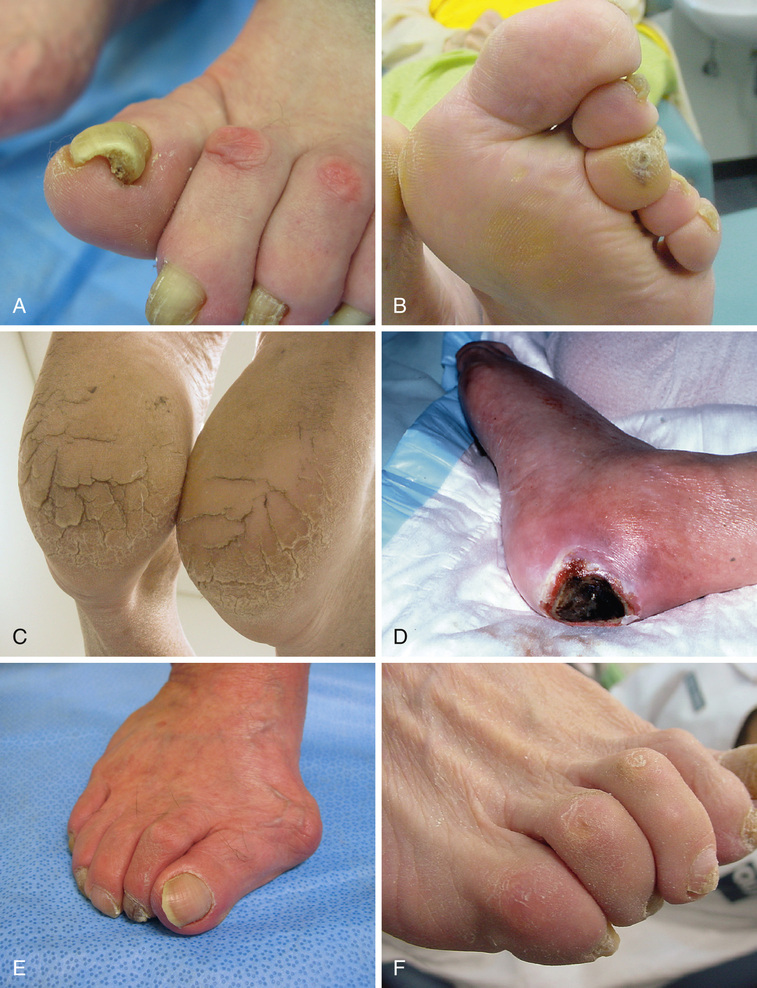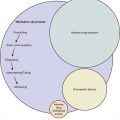Hylton B. Menz The foot plays an important role in all weight-bearing tasks. When walking, the foot contributes to shock absorption, adapts to irregular surfaces, and provides a rigid lever for forward momentum. Aging is associated with significant alterations to the cutaneous, vascular, neurologic, and musculoskeletal characteristics of the foot, all of which may impair this important weight-bearing function.1 As a consequence of these age-related changes, foot pain and deformity are a common accompaniment of advancing age. This chapter briefly outlines the prevalence and consequences of foot problems in older people and provides an overview of the management of some common conditions affecting the feet of older people. Foot pain has long been recognized as a common problem in older people. A recent systematic review and meta-analysis of 31 studies estimated the population prevalence of foot pain to be 24% in people aged 65 years and over, with approximately two thirds reporting at least moderate disability.2 Women report a higher prevalence of foot pain compared to men, possibly because of the detrimental influence of wearing fashion footwear.3 Other identified risk factors for the development of foot pain include obesity, chronic conditions such osteoarthritis, psychological factors such as anxiety and depression, and socioeconomic disadvantage.4–6 There is strong evidence that foot pain and deformity have a significant impact on mobility and health status. Several studies of older people have demonstrated that foot pain is associated with decreased ability to undertake activities of daily living,7 problems with balance and gait,8 an increased risk of falls,9 and poorer health-related quality of life.10 Approximately 20% of older people who are unable to leave their home specifically attribute this to foot pain.11 Physical examination is the basis for diagnosing foot disorders. Observation and palpation, in conjunction with detailed history taking, are generally sufficient to diagnose most common conditions.12 Physical examination of the older person with foot problems involves assessment of skin and appendages, vascular status (including pulse palpation and ankle-brachial index measurement), neurologic status (including sensory testing with graded monofilaments and reflex testing), orthopaedic examination (including foot posture and range-of-motion measurement of the ankle, subtalar, midtarsal, and metatarsophalangeal joints), manual muscle testing, footwear assessment, and observational gait analysis.13 Many interventions for foot problems require some degree of self-management in the home environment. For this reason, an essential component of clinical assessment of older persons with foot problems is evaluating their ability to undertake basic foot care tasks such as cutting and filing nails, applying creams, washing and drying feet, putting on shoes and socks, changing wound dressings, and examining the foot for lesions. To perform these tasks appropriately, the older person requires adequate cognition, grip strength, flexibility, visual acuity, and manual dexterity.14 Onychauxis refers to hypertrophy of the nail plate, which may result from injury, chronic low-grade trauma from ill-fitting shoes, infection, peripheral vascular disease, diabetes, or nutritional deficiency (Figure 104-1, A). Onychauxis is often accompanied by onychophosis, the formation of hyperkeratosis in the nail grooves. If left untreated, hematomas may form under the nail, creating a potential site for infection. Regular maintenance of basic foot hygiene and selection of appropriate footwear may prevent excessive thickening of the nail. However, advanced cases may require treatment by a podiatrist, who will use a special drill to reduce the thickness of the nail. Surgical removal is occasionally indicated, particularly in cases of long-term neglect where the nail may become grossly thickened, curved, and elongated. The term onychocryptosis refers to “ingrown” toenail, where a spicule of nail penetrates the skin, leading to pain, inflammation, and risk of secondary infection. People with abnormally curved nails or overriding toes are more likely to develop onychocryptosis; however, in many cases, the condition is simply caused by inappropriate nail cutting or tightly fitting footwear. Toenails should be cut straight across, and shoes should have sufficient room in the toe box to prevent constriction. Applying topical antiseptics and allowing the nail to grow out normally can successfully manage most cases, but recurrent cases may require removal of the offending portion of nail under local anesthetic. Partial nail avulsion combined with phenolization to destroy nail matrix cells is more effective at preventing recurrence compared to surgical excision, although healing times may be slower.15 Onychomycosis (fungal nail infection) is usually caused by dermatophyte, saprophyte, or yeast organisms and results in yellow-brown discoloration, thickening, and crumbling of the nail plate. Conscientious management of foot hygiene, including washing the feet with soap and water and changing socks daily may prevent many fungal nail infections. Once the condition has developed, it may take some time to achieve a complete cure. A wide range of treatments have been used to treat the condition. However, the gold standard treatment is terbinafine, an oral medication that has been shown to cure the condition in 3 to 6 months.16 In the presence of contraindications to oral medication, topical treatments may be used; however, relief of symptoms takes much longer and cure rates are significantly lower.17 Modest improvements in cure rates can be achieved by combining oral and topical treatments, although achieving adequate compliance may be difficult.18 To prevent recurrence, infected footwear and socks should be discarded or sterilized. Hyperkeratosis is a normal physiologic response to friction applied to the skin, and it develops as a protective mechanism to prevent damage to deeper tissues. However, when the friction applied to the skin becomes excessive, the resultant focal thickening can become extremely painful, increasing the pressure on the underlying dermis. The foot is a common site for the development of hyperkeratosis because of its load-bearing function19 and compression from footwear.3 Broadly, there are two types of hyperkeratosis: calluses, which generally develop on the plantar surface of the foot and appear as a diffuse thickening, and corns (heloma), which are more common on the toes and can be differentiated from a callus by the presence of a sharply demarcated central core (Figure 104-1, B). Corns may also develop underneath the nail bed (subungual heloma)20 or in between the toes (interdigital heloma). Because of the associated moisture, interdigital corns are often soft and macerated.21 Calluses and corns are caused by a range of factors, including ill-fitting footwear, bony prominences, short or long metatarsals, and abnormal plantar loading patterns. In addition to the selection of more appropriate footwear, calluses and corns should be débrided and enucleated by a podiatrist. Simple foam and silicon pads available over the counter at pharmacies can offer effective temporary relief.22 Medicated corn plasters containing salicylic acid are more effective at reducing pain and recurrence of corns than is regular scalpel débridement.23 However, because the application of salicylic acid–containing corn plasters can lead to ulceration in older people with frail skin and/or impaired peripheral vascular supply, they should be used with considerable caution, particularly in people with diabetes.24 Long-term management includes foot orthoses to redistribute excessive plantar loads and surgery to correct any underlying osseous deformity. Xerosis, or dehydration of the skin, is particularly prevalent in older people with diabetes or peripheral vascular disease. Dry skin around the heels often leads to the development of fissures that may extend to the dermis, resulting in pain and risk of infection (Figure 104-1, C). A wide range of emollient preparations (including urea, α-hydroxy acids, lactic acid, lanolin, and ammonium lactate) have been shown to be similarly effective in rehydrating the skin,25,26 with the frequency of application likely to be as important as the active ingredient in the preparation. Deep heel fissures may require débridement of the callused edges and application of an adhesive bandage to limit lateral expansion of the heel when weight bearing, or the application of cyanoacrylate adhesive to seal the fissures until they heal.
Podiatry
Introduction
Epidemiology of Foot Pain in Older People
Clinical Assessment of the Foot in Older People
Common Foot Disorders in Older People and Their Management
Nail Disorders
Onychauxis
Onychocryptosis
Onychomycosis
Skin Disorders
Hyperkeratosis
Xerosis
![]()
Stay updated, free articles. Join our Telegram channel

Full access? Get Clinical Tree


Podiatry
104






